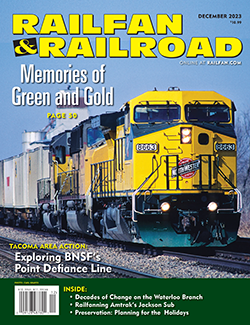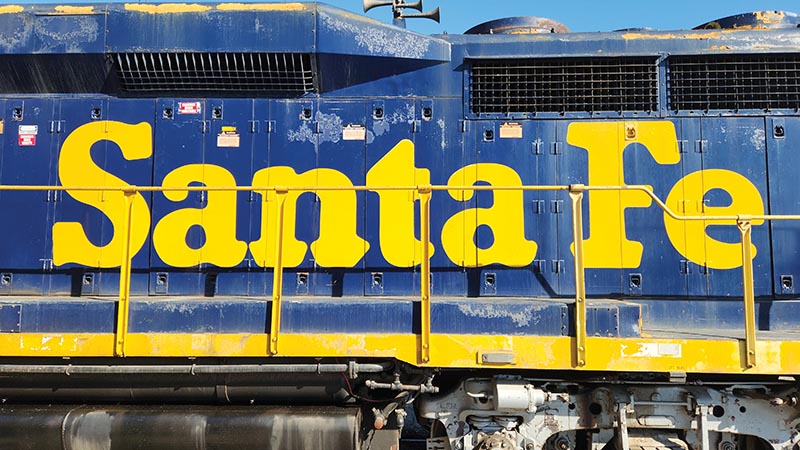 One of the most evocative things about railways has always been their names. Given that most railways in North America were begun as for-profit companies, what a company was called could make a huge difference in its success. A name that referenced connections could make the company legible to a distant investor, while a name with grand dimensions could communicate a company’s ambitions. Perhaps the best example is one of the earliest. In just three words, we immediately know where Baltimore & Ohio was based, as well as its intended reach to the (then) western frontier.
One of the most evocative things about railways has always been their names. Given that most railways in North America were begun as for-profit companies, what a company was called could make a huge difference in its success. A name that referenced connections could make the company legible to a distant investor, while a name with grand dimensions could communicate a company’s ambitions. Perhaps the best example is one of the earliest. In just three words, we immediately know where Baltimore & Ohio was based, as well as its intended reach to the (then) western frontier.
While B&O faded away in 1987, numerous companies continue to use its naming logic. The most famous of these is the short line conglomerate Genesee & Wyoming, which in turn owns more than 100 rail lines across the continent. Many of these subsidiaries carry names with local connotations, joined by an ampersand, such as Buffalo & Pittsburgh, Louisiana & Delta, and St. Lawrence & Atlantic. Why does G&W persist in using these sorts of names? In this case, it’s all about public relations. Local names play better in small towns, local press, or the statehouse; they make G&W’s various operating subsidiaries seem less like parts of a major outsider corporation, and more like part of the community.
Yet not all railways had such elegant and functional names. Consider Chicago, Burlington & Quincy. Chicago? Sure, but Burlington? Quincy? Neither Iowa city is exactly a metropolis. The railway was originally intended to connect its namesakes, but kept growing, until one day it stretched to Kansas City, Mo., and Denver, from Montana to Texas.
A similar story applies to Atchison, Topeka, & Santa Fe Railway. Founded in the late 1850s to link its two namesake towns in Kansas, the name “Santa Fe” at the end was meant to hint at a larger goal, to duplicate the Santa Fe Trail to New Mexico. As the company continued to grow, it began using the “Santa Fe” nickname for marketing, but the official name remained until its end in 1995.
Another naming approach is the ambitious mode. This is formulaic, combining a generic but still geographic term to another that communicates scale. Great Northern. Illinois Central. Canadian National. Best of all? The still-extant Union Pacific. Love it or hate it as a company, the name immediately communicates that it connects the U.S. with the Pacific Ocean.
Some names speak to grand plans that never came to fruition. Chicago, Rock Island & Pacific never met the ocean. New York, Ontario & Western never left the Empire State. St. Louis-San Francisco never expanded west of Texas.
In the last several decades, however, many railway companies seem to have an allergy to identifiable names. The trend likely began with the formation of CSX in the 1980s. The three-letter name is rather clever, as it represented Chessie System (C) and Seaboard System (S), with the “X” standing for expansion beyond just railroads to real estate, intermodal services, and more. However, the name is more of a “backronym,” clever marketing explained after the fact. Nothing in the name clues you in to what region it serves.
Fast forward to the 1996 merger of Burlington Northern and Santa Fe. The combined conglomerate was known as “Burlington Northern Santa Fe,” but just 10 years later, the company changed its formal name to “BNSF Railway” — all meaning removed from the initials to promote corporate simplicity.
More recently, Canadian Pacific merged with Kansas City Southern, and began marketing itself as CPKC. However inelegant this name is, at least the initials stand for something. For now.
Maybe someday, the final round of mergers will occur leaving us with just two, truly transcontinental systems. If that comes to pass, what will it be called? CPKCUPNS? BNSFCSXCN? Atlantic Union and Union National? Maybe X-RAIL or USRail? Only time will tell.
—Alexander Benjamin Craghead is a transportation historian, photographer, artist, and author.



